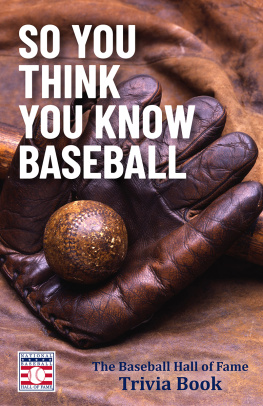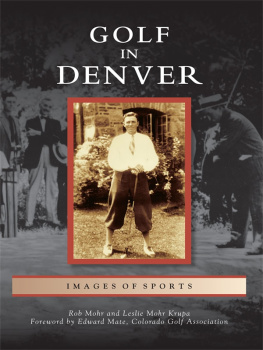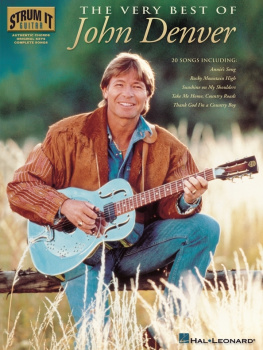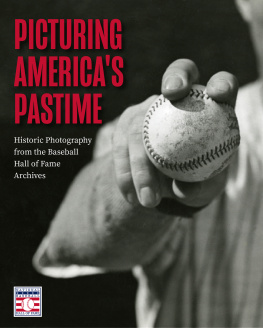
BASEBALL
IN
DENVER

Robert Bus Campbell was a renowned expert in understanding proper pitching mechanics. He also had a keen ability to convey that knowledge to many decades worth of big-league baseball players hailing from the state of Colorado; some are still enjoying big-league careers to this day. Bus lived in Littleton, just south of Denver, but was a graduate of Denvers Manuel High School with famed big leaguer Bruno Konopka. Bus worked with Little Leaguers to Cy Youngaward winners and members of the National Hall of Fame. He is credited with tutoring Roy Halladay since adolescence and signing him to his first professional contract while a scout with the Toronto Blue Jays. Bus also helped resurrect Jaime Moyers career in the early 1990s. He tutored over 30 current or former big-league pitchers, including Goose Gossage, Steve Busby, Shawn Chacon, Jesse Crain, Scott Elarton, Cal Eldred, Nate Field, Luke French, Burt Hooten, Steve Howe, Danny Jackson, Mark Knudsen, Mark Langston, Brad Lidge, and Clint Zavares. This list leaves out countless others who made it to the professional ranks. Bus never accepted a dime for all of his time and tutelage. He served as pitching coach at South and Littleton High Schools, University of Colorado, the fabled Boulder Collegians, University of Northern Colorado, University of Denver, University of Iowa, and lastly at Heritage High School before his passing in the spring of 2008. Bus scouted for the Cardinals, Royals, Reds, Angels, Blue Jays, and Milwaukee Braves of Major League Baseball. Inducted into the Colorado Sports Hall of Fame in 1987, Bus was the consummate family man who was incredibly endearing to all who knew him. His impact on the game of baseball has been immense.
FRONT COVER: Babe Ruth takes batting practice at Merchants Field in October 1927, while in the background Lou Gehrig signs autographs.
COVER BACKGROUND: Bears Stadium is seen on Opening Day in 1948.
BACK COVER: Shown in this 1886 photograph are the Denvers, the citys first truly organized baseball club.
BASEBALL
IN
DENVER

Mat thew Kasper Repplinger II

Copyright 2013 by Matthew Kasper Repplinger II
ISBN 978-0-7385-9959-5
Ebook ISBN 9781439642214
Published by Arcadia Publishing
Charleston, South Carolina
Library of Congress Control Number: 2013935600
For all general information, please contact Arcadia Publishing:
Telephone 843-853-2070
Fax 843-853-0044
E-mail
For customer service and orders:
Toll-Free 1-888-313-2665
Visit us on the Internet at www.arcadiapublishing.com
To my family, who taught me that we are all family; thankfully, I was raised in a baseball family.
CONTENTS
I would like to acknowledge Jay and Alice Sanford, as they were so incredibly gracious and generous with their time. Jay, thank you especially for your immense knowledge of all things Denver and baseball and for being such a warm and loving person. It was a pleasure working with you.
Thanks also go to my baseball friends: Eric Absher, Paul Parker, Gino Grasso, Chris Campassi, Trent Kutler, Matthew Jerebker, Roland Hemond, John Thorn, Rob Neyer, Jonah Keri, Maury Wills, Marc Johnson, Bob Burris, Irv Brown, Cory Schwartz, Meredith Wills, Sabra Anknar, coach Gary Bishop, and Bus Campbell.
Unless otherwise noted, Baseball in Denver photographs are from Jay Sanfords collection.
Prior to the arrival of major-league baseball in the Mile High City, many Americans thought of Denver, Colorado, as a beautiful town with a view of the Rocky Mountains that other cities would die for. Others thought of Denver as the gateway to Ski Country USA and as the home of the Broncos and John Elway.
In 1991, when Major League Baseball awarded Denver a National League expansion franchise, many in the baseball world were doubtful that Denver could become a baseball town. But the citys faithful were not surprised when, in its inaugural season in 1993, the Colorado Rockies set a single-season attendance record. Those not familiar with Denvers sports history would be surprised to know that the city has always been a baseball town.
With Denver still in its infancy and the Civil War entering its second year, the first recorded game of base ball (in the spelling of the time) in Denver took place on April 26, 1862. The McNeils Side defeated the Hulls Side 20-7. The city of Denver grew rapidly, and the amateur game spread quickly as well. Neighborhoods and merchants established teams and issued challenges, through newspapers, for games on Sunday afternoons. As demand grew for more and more baseball, the competition for talented players became intense, and the practice of paying individual players became commonplace. In Denver and throughout Colorado, the level of play had developed to the point that the St. Louis Globe-Democrat began to cover the regions games in 1876. The influx of professional players into Denver allowed team owners to begin charging spectators to see their clubs play. In 1879, the Denver Browns became the first fully professional team when it represented the city in a series of games against a Salt Lake City ball club.
In 1886, a team named simply the Denvers became the citys first participant in organized baseball when it joined the new Western League. The club boasted seven men who would go on to the big leagues, including Joe Straub, Dan Dugdale, Billy Mountjoy, Baldy Silch, George Tebeau, and Flaming Darby OBrien. The arrival of Dave Rowe and George Tebeau in Denver was vital to the expansion of professional and amateur baseball in the city in the 1880s. Rowe and Tebeau are rightly referred to as the fathers of Denver baseball. At various times, both men played major-league baseball, managed at the professional level, and owned the Denver minor-league franchise.
Major-league teams regularly barnstormed through Denver, starting when Dave Rowe brought his Kansas City Cowboys to town in 1886. Next came the Philadelphia Phillies (1887), the Chicago White Stockings (now the Cubs), and the All-America Team, which had embarked on a world tour in 1888. The St. Louis, Cleveland, and Boston teams also played in Denver in the 1880s. Denver had developed into such a hotbed for baseball that George Tebeau was able to convince the renowned Cap Anson to bring his Chicago team to the city in 1891 for spring training. Tebeau also championed the inclusion of African American professional players, such as George Taylor and William Castone, on the rosters of white teams.
Denver baseball fans knew talent when they saw it, and they saw an abundance of it. Before the dawn of the 20th century, nearly 20 of the citys players reached the major leagues. When the Colorado Rockies took the field at Mile High Stadium on April 9, 1993, in front of over 80,000 fans, Denver became a big-league townbut Denver had always been a baseball town. Dave Rowe and George Tebeau would have been proud.
Jay Sanford
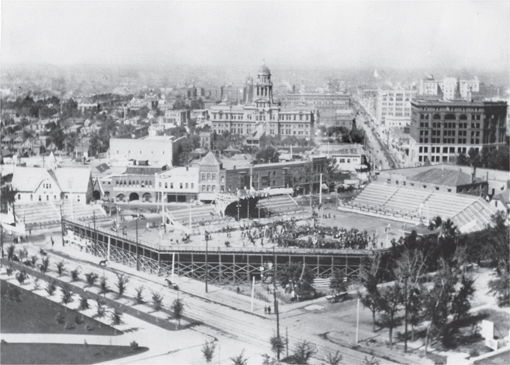
The Broadway Grounds were located at Broadway Boulevard and Colfax Avenue between Sixteenth Street and Lincoln Avenue. This photograph was taken from the Colorado State Capitol Building, looking north-northwest. The domed building in the center is the Arapahoe County Courthouse, located on the future sight of the May D&F Store and the famous ice rink and clock tower. The Broadway Grounds site was used for baseball in Denver as early as 1862.
Next page

